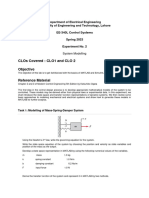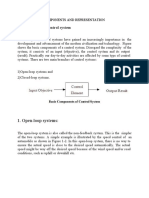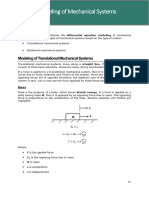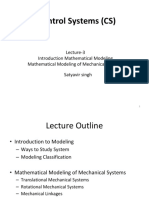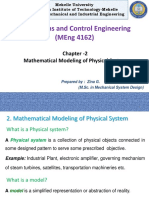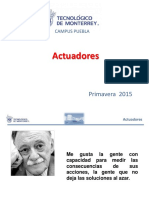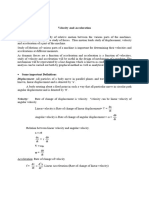05/25/2024
The sensor is responsible for measuring the output or the
Sensor (or state of the plant. It converts the physical quantity (such as
Transducer) temperature, pressure, position, etc.) into an electrical
signal that can be processed by the controller.
The feedback path is responsible for providing information
about the system's output back to the controller. It ensures
that the controller can continuously monitor the system's
Feedback Path performance and make adjustments as necessary to
maintain stability and achieve the desired setpoint.
The reference input, also known as the setpoint, is the
desired value or trajectory that the system aims to achieve
Reference Input or track. It represents the target performance or operating
condition that the controller strives to maintain.
11
A variable resistor, called a potentiometer, is shown.
Practice The resistance is varied by moving a wiper arm along a
Examples fixed resistance. The resistance from A to C is fixed,
but the resistance from B to C varies with the position
of the wiper arm. If it takes 10 turns to move the wiper
arm from A to C, draw a block diagram of the
potentiometer showing the input variable, the output
variable, and (inside the block) the gain, which is a
constant and is the amount by which the input is
multiplied to obtain the output.
An aircraft’s attitude varies in roll, pitch, and yaw as
defined in the Figure. Draw a functional block diagram
for a closed-loop system that stabilizes the roll as
follows: The system measures the actual roll angle
with a gyro and compares the actual roll angle with
the desired roll angle. The ailerons respond to the roll-
angle error by undergoing an angular deflection. The
aircraft responds to this angular deflection, producing
a roll angle rate. Identify the input and output
transducers, the controller, and the plant. Further,
identify the nature of each signal.
12
1
� 05/25/2024
A mathematical model of a dynamic system is defined as
a set of equations that represents the dynamics of the
system accurately, or at least fairly well.
Mathematical
Note that a mathematical model is not unique to a given
Modelling system. A system may be represented in many different
of Physical ways and, therefore, may have many mathematical
Systems models, depending on one’s perspective.
The dynamics of many systems, whether they are
mechanical, electrical, thermal, economic, biological, and
so on, may be described in terms of differential equations.
Such differential equations may be obtained by using
physical laws governing a particular system—for example,
Newton’s laws for mechanical systems and Kirchhoff’s
laws for electrical systems.
We must always keep in mind that deriving reasonable
mathematical models is the most important part of the
entire analysis of control systems.
13
Translational Motion Dashpot
Mass is the property of a body, which stores kinetic If a force is applied on dashpot B, then it is opposed by an
energy. If a force is applied on a body having mass M, opposing force due to friction of the dashpot. This
then it is opposed by an opposing force due to mass. opposing force is proportional to the velocity of the body.
This opposing force is proportional to the acceleration Assume mass and elasticity are negligible.
of the body. Assume elasticity and friction are
negligible.
Where, •Fb is the opposing force due to
friction of dashpot
•F is the applied force
•B is the frictional coefficient
•Fm is the opposing
force due to mass •v is velocity
•M is mass •x is displacement
•a is acceleration
•x is displacement
14
2
� 05/25/2024
Spring Rotational System
Spring is an element, which stores potential energy. If a In a translational mechanical system, mass stores kinetic
force is applied on spring K, then it is opposed by an energy. Similarly, in a rotational mechanical system, a
opposing force due to elasticity of spring. This opposing moment of inertia stores kinetic energy. If a torque is applied
force is proportional to the displacement of the spring. on a body having a moment of inertia J, then it is opposed by
Assume mass and friction are negligible. an opposing torque due to the moment of inertia. This
opposing torque is proportional to the angular acceleration
of the body. Assume elasticity and friction are negligible.
•Where,
•T is the applied torque
Where,
•Tj is the opposing torque
•F is the applied force
due to moment of inertia
•Fk is the opposing force due
to elasticity of spring •J is moment of inertia
•K is spring constant •α is angular acceleration
•x is displacement •θ is angular displacement
15
Torsional Spring Dashpot
If a torque is applied on torsional spring K, then it is If a torque is applied on dashpot B, then it is opposed by
opposed by an opposing torque due to the elasticity of an opposing torque due to the rotational friction of the
torsional spring. This opposing torque is proportional to dashpot. This opposing torque is proportional to the
the angular displacement of the torsional spring. angular velocity of the body. Assume the moment of
Assume that the moment of inertia and friction are inertia and elasticity are negligible.
negligible.
Where,
•Tb is the opposing torque due
to the rotational friction of the
dashpot
•B is the rotational friction
coefficient
•ω is the angular velocity
•θ is the angular displacement
16
3
� 05/25/2024
Mass-Dash pot-Spring System Electrical System
Mesh equation for this circuit is
The above equation is a second-order differential
equation.
17
Develop the mathematical model for the following systems
For the rotational system shown, write the equations of motion
18
4
� 05/25/2024
Force Voltage Analogy
Mesh equation for this circuit is
By comparing Equation 1 and Equation 3, we will get
the analogous quantities of the translational
mechanical system and electrical system. The
following table shows these analogous quantities.
19
Translational Mechanical System Electrical System
Force(F) Voltage(V)
Mass(M) Inductance(L)
Frictional Coefficient(B) Resistance(R)
Spring Constant(K) Reciprocal of Capacitance
Displacement(x) Charge(q)
Velocity(v) Current(i)
20


















